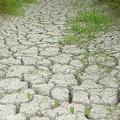 新的研究顯示,在這個世紀末,氣候變遷將使熱帶地區及亞熱帶地區的農作物產量縮水,讓全球半數人口面臨糧食危機之中,除非我們能夠很快找到適應的方法。
新的研究顯示,在這個世紀末,氣候變遷將使熱帶地區及亞熱帶地區的農作物產量縮水,讓全球半數人口面臨糧食危機之中,除非我們能夠很快找到適應的方法。
這些處於危機之中的地區從美國南部延伸至阿根廷北邊及巴西南部,從印度北部及中國南方延伸至澳洲南部及整個非洲。
目前有30億人口生活在熱帶及亞熱帶地區,而這個數字預期在本世紀末將會成長至2倍。很多目前居住在這些區域的人們每天僅有少於2美元的生活費用,且大部分依賴農業來維持生計。
這項研究刊登在最近一期《科學》(Science)期刊上,主要作者的華盛頓大學(University of Washington)大氣科學教授貝堤斯堤(David Battisti)表示:「單是由氣溫所造成的全球糧食生產壓力就將逐漸變大,這還沒有將因為氣溫變高所增加水源供應壓力考慮在內呢!」
他指出:「你可以使這種情形發生並且很痛苦地去適應它,或是規劃因應他的方法。你也可以減緩它的影響並在第一時間點預防它的發生,但是我們現在作的並不好。」
貝堤斯堤與史丹佛大學(Stanford University)糧食安全與環境專案計畫(Program on Food Security and the Environment)主任奈以勒(Rosamond Naylor)合作進行氣候變遷對全世界糧食危機衝擊的檢驗,由美國國家科學基金會(National Science Foundation)及西雅圖塔瑪基金會(Tamaki Foundation)出資贊助。
奈以勒表示:「這是一個讓我們投資在適應上具有說服力的理由,由於氣溫上的變化,很明確地這是一個我們即將前進的方向,而這項工作將需要數十年來發展可耐受較高溫氣候條件的新糧食作物種類。」
她指出:「我們用歷史上觀察到最惡劣的情況去作預測,並且可以預見未來將會更加惡化,除非有適應機制被發展出來。」
聯合國糧食農業組織(UN Food and Agriculture Organization)2008年12月時指出,目前全世界67.5億人口中有將近10億人在飢餓狀態之下入睡,而因為糧食價格居高不下,其他4000萬人今年也已經被推向飢餓狀態。這些增加的數字還是國際社群共同協助了40年的進展,將飢餓人口比例由37%降低至17%。
貝堤斯堤與奈以勒表示,未來在熱帶地區預期將會有更高的氣溫出現,致使主要糧食作物、玉米及稻米產量減少20%到40%,而持續升高的氣溫也會將土壤濕氣蒸乾,進一步降低作物產量。
貝堤斯堤指出:「當所有徵兆都指向同一個方向,一個不好的方向,你大概就會知道將會發什麼事了。這裡所說的事指的是有額外幾億人將會加入尋找糧食的行列,因為他們在現有生產糧食的地方已經找不到糧食了。」
貝堤斯堤與奈以勒將實際觀察的狀況與全球23個氣候模式的資料加以結合,發現有超過90%的機率,在2100年時熱帶及亞熱帶地區作物生長季節的最低氣溫,會高於有史以來的最高紀錄。
Climate change will desiccate crop yields in the tropics and subtropics by the end of this century, leaving half the world's population facing a food crisis unless methods of adaptation are found quickly, new research shows.
The area at risk stretches from the southern United States to northern Argentina and southern Brazil, from northern India and southern China to southern Australia and all of Africa.
Currently three billion people live in the tropics and subtropics, and their number is expected to nearly double by the end of the century. Many people who now live in these areas subsist on less than $2 a day and depend largely on agriculture for their livelihoods.
"The stresses on global food production from temperature alone are going to be huge, and that doesn't take into account water supplies stressed by the higher temperatures," said David Battisti, a University of Washington atmospheric sciences professor and lead author of the study in the current edition of the journal "Science."
"You can let it happen and painfully adapt, or you can plan for it," he said. "You also could mitigate it and not let it happen in the first place, but we're not doing a very good job of that."
Battisti collaborated with Rosamond Naylor, director of Stanford University's Program on Food Security and the Environment, to examine the impact of climate change on the world's food security. The National Science Foundation and the Tamaki Foundation funded their research.
"This is a compelling reason for us to invest in adaptation, because it is clear that this is the direction we are going in terms of temperature and it will take decades to develop new food crop varieties that can better withstand a warmer climate," Naylor said.
"We are taking the worst of what we've seen historically and saying that in the future it is going to be a lot worse unless there is some kind of adaptation," she said.
Today, nearly one billion of the world's 6.75 billion people go to bed hungry, the UN Food and Agriculture Organization said in December. Another 40 million people have been pushed into hunger this year due to high food prices, the agency said. This increase comes after four decades of progress when the international community collectively helped to bring down the percentage of hungry people from 37 to 17.
In the future, Battisti and Naylor says, higher temperatures in the tropics can be expected to cut yields of the primary food crops, maize and rice, by 20 to 40 percent. And rising temperatures also will dry up soil moisture, cutting yields even further.
"When all the signs point in the same direction, and in this case it's a bad direction, you pretty much know what's going to happen," Battisti said. "You are talking about hundreds of millions of additional people looking for food because they won't be able to find it where they find it now."
By combining direct observations with data from 23 global climate models, Battisti and Naylor determined there is greater than a 90 percent probability that by 2100 the lowest growing-season temperatures in the tropics and subtropics will be higher than any temperatures recorded there to date.





